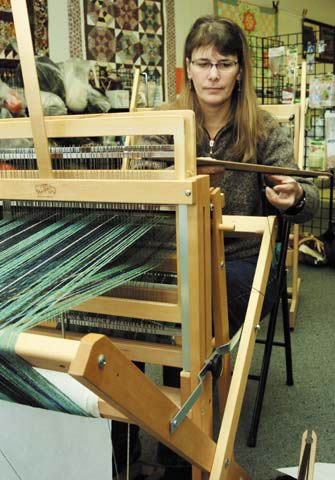Making magic with fiber and thread
Published 3:37 pm Wednesday, December 2, 2009

- Denine Schmitz prefers working with a loom to create the types of patterns she likes best. She's a member of The Threadbenders club, some of whom talk about their art beginning on Page 4. (Baker City Herald/S. John Collins)
The Threadbenders use many different techniques to create their works of art
Trending
The women just keep coming through the door of LaDonna’s Fiber Arts,
each with a smile on her face and a bag of goodies on her arm.
These are the Threadbenders, a guild of artists from Baker, Union
Trending
and Wallowa counties who make all sorts of works that fall under the
general description of “fiber arts.”
And they make their art sound so easy.
“Over, under, over, under. That’s all you need to know,” Denine Schmitz says of weaving.
Yeah, right.
When the weavers in the group sit at a loom, magic happens as they
work the yarn and treadles to create a pattern for a rug, or a shawl or
pretty much anything they want to make.
And when they start talking their trade, a newcomer to the group
hears words that sound more like a foreign language than English.
“Warp,” for example, refers to the long threads on the loom, and the “weft” are the threads woven across the warp.
And that weaving action? It’s called “throwing shots.”
When all these phrases elicit a confused face, a voice from the back
says, with a bit of a chuckle, “Learning to weave requires learning a
new language.”
But if the words take a while to grasp, the beauty of these art forms are easy to appreciate.
And the community can see a wide variety of these fiber arts during the Threadbenders Guild third-annual show and sale that happens this weekend, Dec. 4 and 5, at Clark and Company Home, 1924 Broadway St.
The show begins Friday from 5 p.m. to 8 p.m., which coincides with the First Friday art show openings at Crossroads Carnegie Art Center and The Short Term Gallery.
The event continues Saturday from 11 a.m. to 5 p.m. Throughout the day, artists will demonstrate techniques and provide opportunities to try spinning and weaving.
Featured items for this show include yarns, rugs, bags, scarves, baskets, shawls, throws, table runners, placemats, wall hangings and “wearables.”
The Threadbenders Guild is a mixture of talents – some have been honing their craft for years while others are just learning the art form.
Laurene Chapman began weaving in the 1980s and has produced many works she describes as “Navajo style.”
“I just always liked it, and took a seminar,” she says.
She doesn’t, however, ever sell these Navajo-inspired works out of respect for the Navajos who make a living by selling their woven works.
“I make a trip to New Mexico every once in a while to buy a rug,” Chapman says.
And when you look at her weaving, take note of the “spirit trail” located in the northeast corner.
“So the spirit doesn’t get trapped,” she says.
She gives her creations to family.
“I just enjoy doing it, and the kids and the grandkids enjoying getting them,” she says.
As with any form of art, techniques and styles evolve over the years.
“There are no errors, just design opportunities,” Schmitz says with a smile.
“You make one mistake, it’s a mistake. You repeat it two more times and it’s a design element,” Kirsten Badger says.
Across the room sits Margaret Mead, who is using an ankle loom to make, well, something.
“It could be a belt, something to hang, or a camera strap,” she says.
A variety of looms will be on display during this weekend’s show, from the small ankle looms to the tall harness looms.
In addition to weaving, Mead also colors her own fibers using natural dyes made from carrot tops, beets, onion skins, even frosted zucchini leaves.
“We’ve dyed just about everything,” she says.
Most of these create muted hues of yellows and reds.
“With natural dyes, the colors blend together,” Mead says.
Another technique these Threadbenders experiment with is felting, which is basically rubbing fibers together with water.
Mickey Edwards describes it better: You put down layer upon layer of wool, add warm water and some alkaline soap, then start rubbing. The water opens the wool fibers, and the friction from rubbing interlocks those fibers to create a strong material.
There’s almost as many types of fibers as there are techniques.
“I have some yak at home,” Edwards says.
That fiber is so fine, she says, that 6 ounces yields nearly 1,000 yards.
“The best thing about fiber arts is you get to touch everything,” Edwards says as she pulls apart wispy silk threads.
Using these nearly invisible fibers requires a bit of patience, considering that a technique called “silk fusion” uses “hundreds of thousands, if not a million, fibers.”
The possibilities are endless for these Threadbenders – just learn the basics first, they say.
“We do all kinds of things – that’s what’s neat about weaving,” Badger says. “There’s always something new you can try.”
And just to clear up a misconception – basket weaving isn’t easy.
“Try it sometime,” Edwards says with a grin.
Of course, you might get hooked.
“There are so many different things you can do, I don’t have time for anything else,” Mead says.
But these women seem to enjoy the company as much as the art.
“It’s worth learning to weave just to meet this bunch of women,” Chapman said.
“A friend said if you can find the weavers in the community – instant friends,” Schmitz says.
neat about weaving,” Badger says. “There’s always something new you can try.”
And just to clear up a misconception – basket weaving isn’t easy.
“Try it sometime,” Edwards says with a grin.
Of course, you might get hooked.
“There are so many different things you can do, I don’t have time for anything else,” Mead says.
But these women seem to enjoy the company as much as the art.
“It’s worth learning to weave just to meet this bunch of women,” Chapman said.
“A friend said if you can find the weavers in the community – instant friends,” Schmitz says.









